Global Malaria Action Plan: A Policy for Malaria Prevention and Intervention
VerifiedAdded on 2023/06/07
|12
|3792
|99
AI Summary
This report discusses the Global Malaria Action Plan (GMAP) as a policy for malaria prevention and intervention. It provides an overview of GMAP, the current scenario of malaria, and the global and regional strategies to reduce the burden of malaria worldwide. The report also highlights the challenges in achieving sustained control, elimination, and eradication of malaria.
Contribute Materials
Your contribution can guide someone’s learning journey. Share your
documents today.
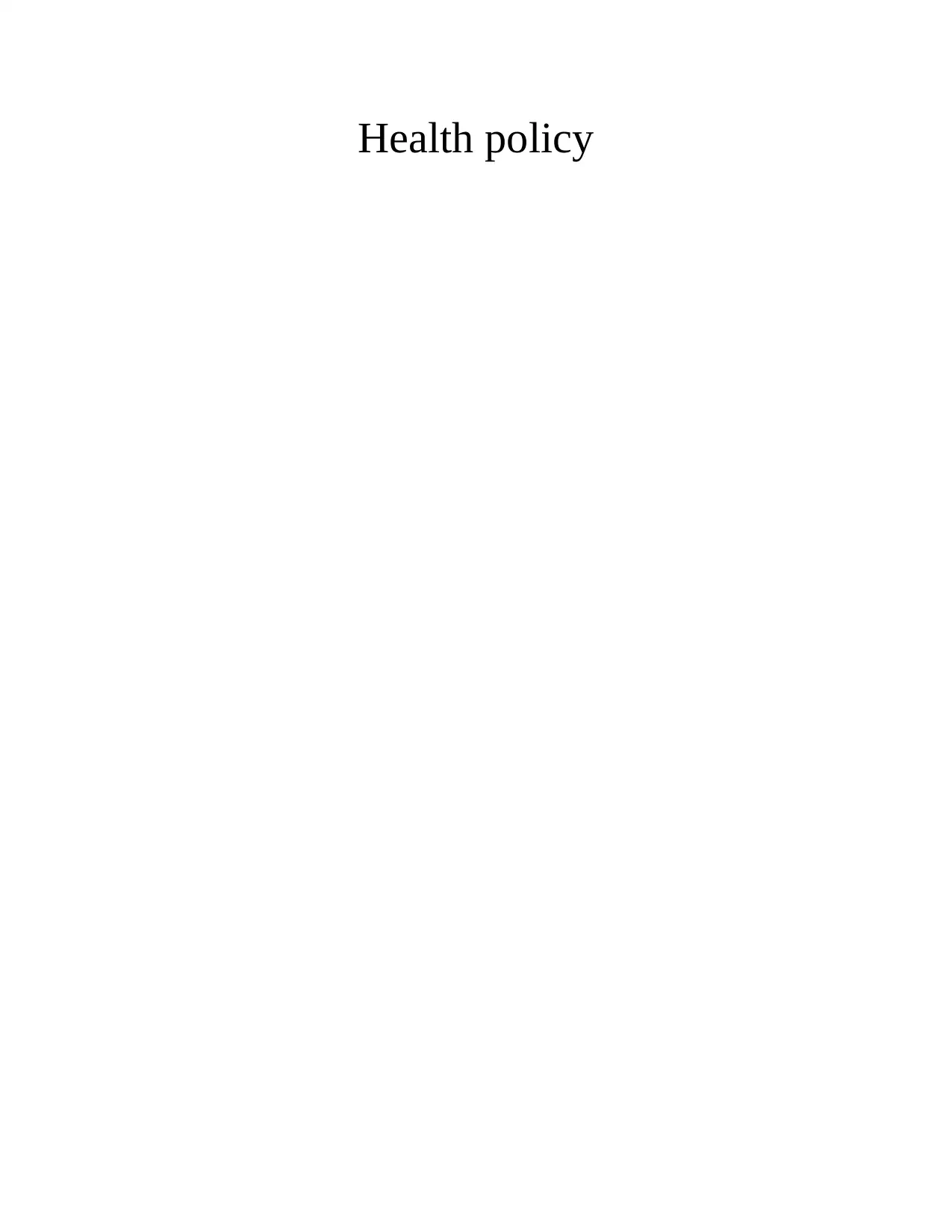
Health policy
Secure Best Marks with AI Grader
Need help grading? Try our AI Grader for instant feedback on your assignments.
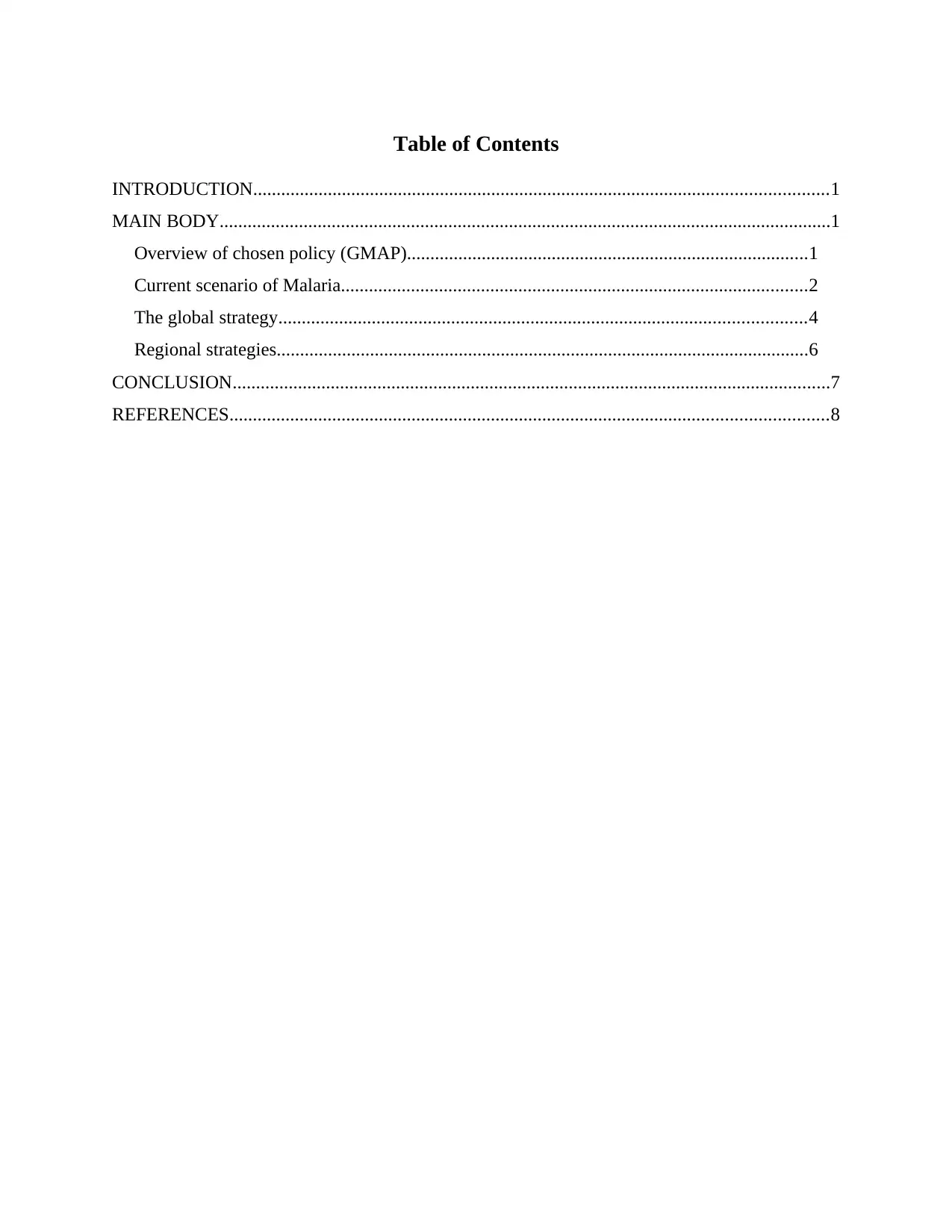
Table of Contents
INTRODUCTION...........................................................................................................................1
MAIN BODY...................................................................................................................................1
Overview of chosen policy (GMAP)......................................................................................1
Current scenario of Malaria....................................................................................................2
The global strategy.................................................................................................................4
Regional strategies..................................................................................................................6
CONCLUSION................................................................................................................................7
REFERENCES................................................................................................................................8
INTRODUCTION...........................................................................................................................1
MAIN BODY...................................................................................................................................1
Overview of chosen policy (GMAP)......................................................................................1
Current scenario of Malaria....................................................................................................2
The global strategy.................................................................................................................4
Regional strategies..................................................................................................................6
CONCLUSION................................................................................................................................7
REFERENCES................................................................................................................................8
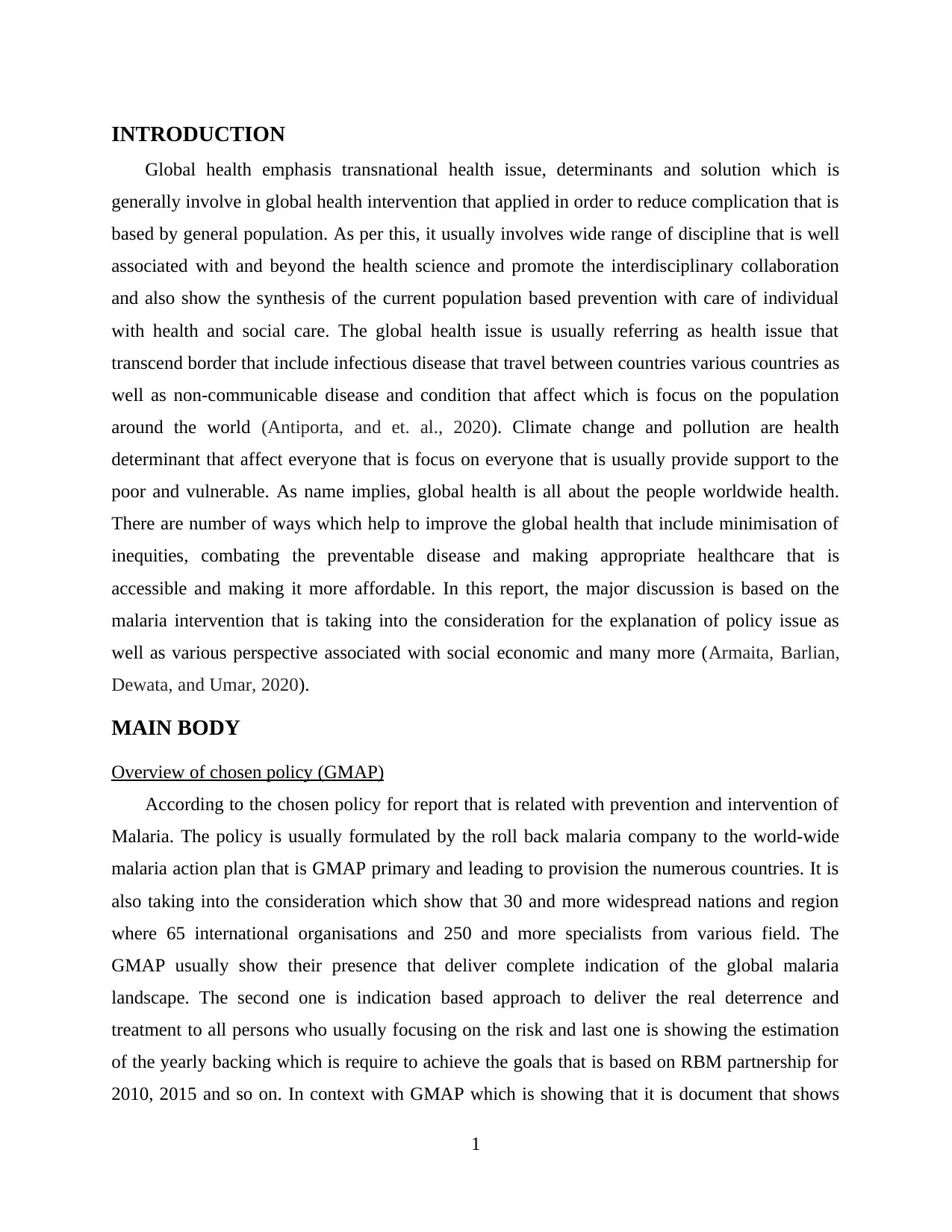
INTRODUCTION
Global health emphasis transnational health issue, determinants and solution which is
generally involve in global health intervention that applied in order to reduce complication that is
based by general population. As per this, it usually involves wide range of discipline that is well
associated with and beyond the health science and promote the interdisciplinary collaboration
and also show the synthesis of the current population based prevention with care of individual
with health and social care. The global health issue is usually referring as health issue that
transcend border that include infectious disease that travel between countries various countries as
well as non-communicable disease and condition that affect which is focus on the population
around the world (Antiporta, and et. al., 2020). Climate change and pollution are health
determinant that affect everyone that is focus on everyone that is usually provide support to the
poor and vulnerable. As name implies, global health is all about the people worldwide health.
There are number of ways which help to improve the global health that include minimisation of
inequities, combating the preventable disease and making appropriate healthcare that is
accessible and making it more affordable. In this report, the major discussion is based on the
malaria intervention that is taking into the consideration for the explanation of policy issue as
well as various perspective associated with social economic and many more (Armaita, Barlian,
Dewata, and Umar, 2020).
MAIN BODY
Overview of chosen policy (GMAP)
According to the chosen policy for report that is related with prevention and intervention of
Malaria. The policy is usually formulated by the roll back malaria company to the world-wide
malaria action plan that is GMAP primary and leading to provision the numerous countries. It is
also taking into the consideration which show that 30 and more widespread nations and region
where 65 international organisations and 250 and more specialists from various field. The
GMAP usually show their presence that deliver complete indication of the global malaria
landscape. The second one is indication based approach to deliver the real deterrence and
treatment to all persons who usually focusing on the risk and last one is showing the estimation
of the yearly backing which is require to achieve the goals that is based on RBM partnership for
2010, 2015 and so on. In context with GMAP which is showing that it is document that shows
1
Global health emphasis transnational health issue, determinants and solution which is
generally involve in global health intervention that applied in order to reduce complication that is
based by general population. As per this, it usually involves wide range of discipline that is well
associated with and beyond the health science and promote the interdisciplinary collaboration
and also show the synthesis of the current population based prevention with care of individual
with health and social care. The global health issue is usually referring as health issue that
transcend border that include infectious disease that travel between countries various countries as
well as non-communicable disease and condition that affect which is focus on the population
around the world (Antiporta, and et. al., 2020). Climate change and pollution are health
determinant that affect everyone that is focus on everyone that is usually provide support to the
poor and vulnerable. As name implies, global health is all about the people worldwide health.
There are number of ways which help to improve the global health that include minimisation of
inequities, combating the preventable disease and making appropriate healthcare that is
accessible and making it more affordable. In this report, the major discussion is based on the
malaria intervention that is taking into the consideration for the explanation of policy issue as
well as various perspective associated with social economic and many more (Armaita, Barlian,
Dewata, and Umar, 2020).
MAIN BODY
Overview of chosen policy (GMAP)
According to the chosen policy for report that is related with prevention and intervention of
Malaria. The policy is usually formulated by the roll back malaria company to the world-wide
malaria action plan that is GMAP primary and leading to provision the numerous countries. It is
also taking into the consideration which show that 30 and more widespread nations and region
where 65 international organisations and 250 and more specialists from various field. The
GMAP usually show their presence that deliver complete indication of the global malaria
landscape. The second one is indication based approach to deliver the real deterrence and
treatment to all persons who usually focusing on the risk and last one is showing the estimation
of the yearly backing which is require to achieve the goals that is based on RBM partnership for
2010, 2015 and so on. In context with GMAP which is showing that it is document that shows
1
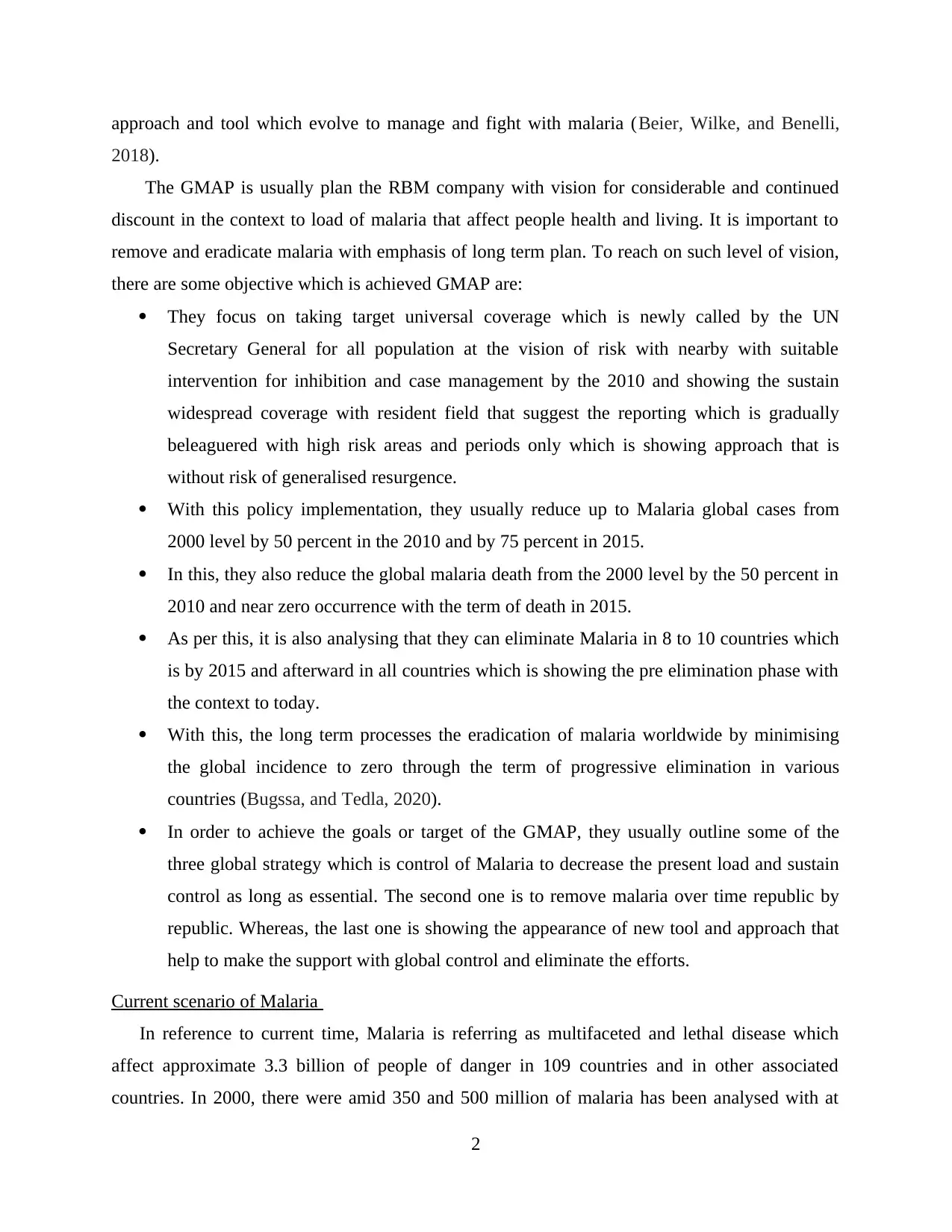
approach and tool which evolve to manage and fight with malaria (Beier, Wilke, and Benelli,
2018).
The GMAP is usually plan the RBM company with vision for considerable and continued
discount in the context to load of malaria that affect people health and living. It is important to
remove and eradicate malaria with emphasis of long term plan. To reach on such level of vision,
there are some objective which is achieved GMAP are:
They focus on taking target universal coverage which is newly called by the UN
Secretary General for all population at the vision of risk with nearby with suitable
intervention for inhibition and case management by the 2010 and showing the sustain
widespread coverage with resident field that suggest the reporting which is gradually
beleaguered with high risk areas and periods only which is showing approach that is
without risk of generalised resurgence.
With this policy implementation, they usually reduce up to Malaria global cases from
2000 level by 50 percent in the 2010 and by 75 percent in 2015.
In this, they also reduce the global malaria death from the 2000 level by the 50 percent in
2010 and near zero occurrence with the term of death in 2015.
As per this, it is also analysing that they can eliminate Malaria in 8 to 10 countries which
is by 2015 and afterward in all countries which is showing the pre elimination phase with
the context to today.
With this, the long term processes the eradication of malaria worldwide by minimising
the global incidence to zero through the term of progressive elimination in various
countries (Bugssa, and Tedla, 2020).
In order to achieve the goals or target of the GMAP, they usually outline some of the
three global strategy which is control of Malaria to decrease the present load and sustain
control as long as essential. The second one is to remove malaria over time republic by
republic. Whereas, the last one is showing the appearance of new tool and approach that
help to make the support with global control and eliminate the efforts.
Current scenario of Malaria
In reference to current time, Malaria is referring as multifaceted and lethal disease which
affect approximate 3.3 billion of people of danger in 109 countries and in other associated
countries. In 2000, there were amid 350 and 500 million of malaria has been analysed with at
2
2018).
The GMAP is usually plan the RBM company with vision for considerable and continued
discount in the context to load of malaria that affect people health and living. It is important to
remove and eradicate malaria with emphasis of long term plan. To reach on such level of vision,
there are some objective which is achieved GMAP are:
They focus on taking target universal coverage which is newly called by the UN
Secretary General for all population at the vision of risk with nearby with suitable
intervention for inhibition and case management by the 2010 and showing the sustain
widespread coverage with resident field that suggest the reporting which is gradually
beleaguered with high risk areas and periods only which is showing approach that is
without risk of generalised resurgence.
With this policy implementation, they usually reduce up to Malaria global cases from
2000 level by 50 percent in the 2010 and by 75 percent in 2015.
In this, they also reduce the global malaria death from the 2000 level by the 50 percent in
2010 and near zero occurrence with the term of death in 2015.
As per this, it is also analysing that they can eliminate Malaria in 8 to 10 countries which
is by 2015 and afterward in all countries which is showing the pre elimination phase with
the context to today.
With this, the long term processes the eradication of malaria worldwide by minimising
the global incidence to zero through the term of progressive elimination in various
countries (Bugssa, and Tedla, 2020).
In order to achieve the goals or target of the GMAP, they usually outline some of the
three global strategy which is control of Malaria to decrease the present load and sustain
control as long as essential. The second one is to remove malaria over time republic by
republic. Whereas, the last one is showing the appearance of new tool and approach that
help to make the support with global control and eliminate the efforts.
Current scenario of Malaria
In reference to current time, Malaria is referring as multifaceted and lethal disease which
affect approximate 3.3 billion of people of danger in 109 countries and in other associated
countries. In 2000, there were amid 350 and 500 million of malaria has been analysed with at
2
Secure Best Marks with AI Grader
Need help grading? Try our AI Grader for instant feedback on your assignments.
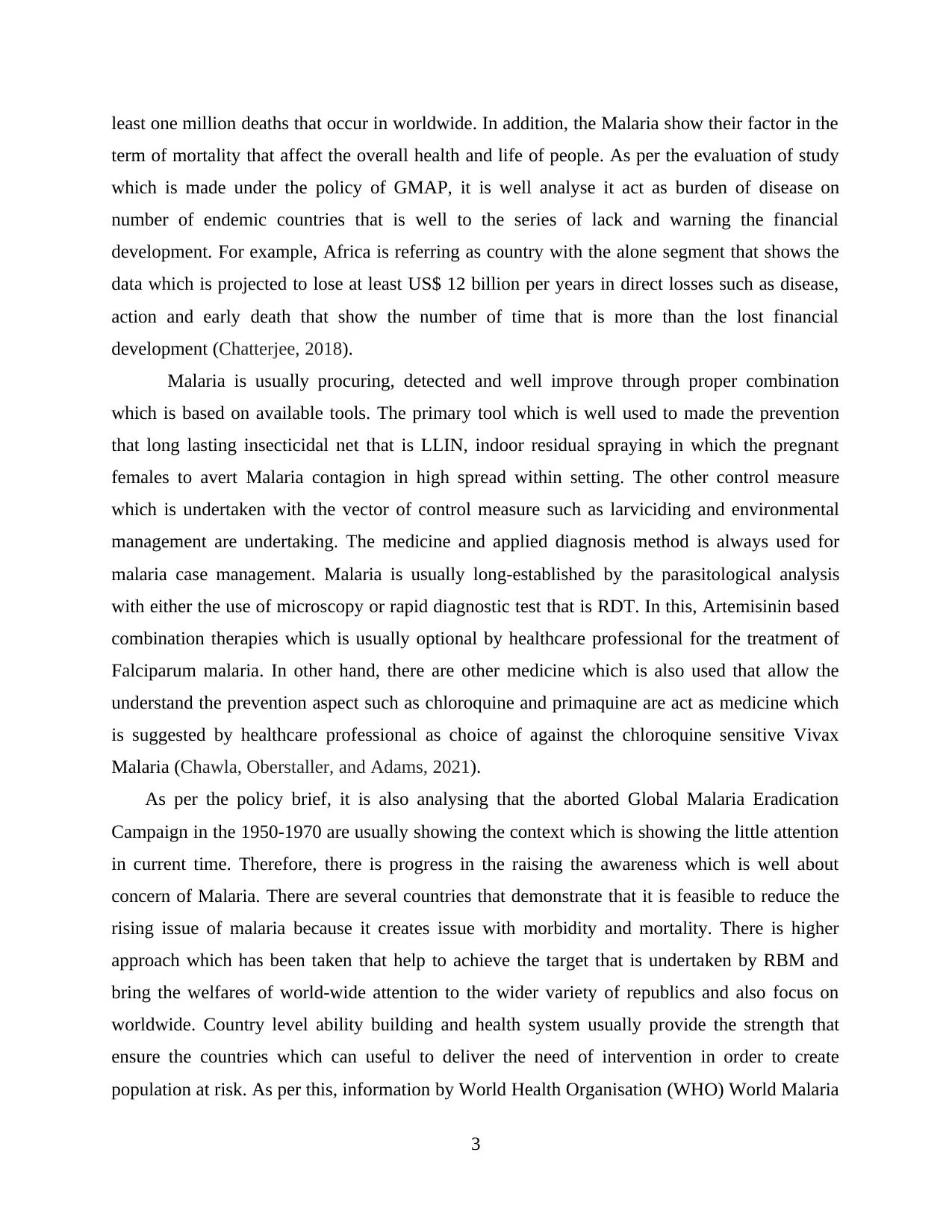
least one million deaths that occur in worldwide. In addition, the Malaria show their factor in the
term of mortality that affect the overall health and life of people. As per the evaluation of study
which is made under the policy of GMAP, it is well analyse it act as burden of disease on
number of endemic countries that is well to the series of lack and warning the financial
development. For example, Africa is referring as country with the alone segment that shows the
data which is projected to lose at least US$ 12 billion per years in direct losses such as disease,
action and early death that show the number of time that is more than the lost financial
development (Chatterjee, 2018).
Malaria is usually procuring, detected and well improve through proper combination
which is based on available tools. The primary tool which is well used to made the prevention
that long lasting insecticidal net that is LLIN, indoor residual spraying in which the pregnant
females to avert Malaria contagion in high spread within setting. The other control measure
which is undertaken with the vector of control measure such as larviciding and environmental
management are undertaking. The medicine and applied diagnosis method is always used for
malaria case management. Malaria is usually long-established by the parasitological analysis
with either the use of microscopy or rapid diagnostic test that is RDT. In this, Artemisinin based
combination therapies which is usually optional by healthcare professional for the treatment of
Falciparum malaria. In other hand, there are other medicine which is also used that allow the
understand the prevention aspect such as chloroquine and primaquine are act as medicine which
is suggested by healthcare professional as choice of against the chloroquine sensitive Vivax
Malaria (Chawla, Oberstaller, and Adams, 2021).
As per the policy brief, it is also analysing that the aborted Global Malaria Eradication
Campaign in the 1950-1970 are usually showing the context which is showing the little attention
in current time. Therefore, there is progress in the raising the awareness which is well about
concern of Malaria. There are several countries that demonstrate that it is feasible to reduce the
rising issue of malaria because it creates issue with morbidity and mortality. There is higher
approach which has been taken that help to achieve the target that is undertaken by RBM and
bring the welfares of world-wide attention to the wider variety of republics and also focus on
worldwide. Country level ability building and health system usually provide the strength that
ensure the countries which can useful to deliver the need of intervention in order to create
population at risk. As per this, information by World Health Organisation (WHO) World Malaria
3
term of mortality that affect the overall health and life of people. As per the evaluation of study
which is made under the policy of GMAP, it is well analyse it act as burden of disease on
number of endemic countries that is well to the series of lack and warning the financial
development. For example, Africa is referring as country with the alone segment that shows the
data which is projected to lose at least US$ 12 billion per years in direct losses such as disease,
action and early death that show the number of time that is more than the lost financial
development (Chatterjee, 2018).
Malaria is usually procuring, detected and well improve through proper combination
which is based on available tools. The primary tool which is well used to made the prevention
that long lasting insecticidal net that is LLIN, indoor residual spraying in which the pregnant
females to avert Malaria contagion in high spread within setting. The other control measure
which is undertaken with the vector of control measure such as larviciding and environmental
management are undertaking. The medicine and applied diagnosis method is always used for
malaria case management. Malaria is usually long-established by the parasitological analysis
with either the use of microscopy or rapid diagnostic test that is RDT. In this, Artemisinin based
combination therapies which is usually optional by healthcare professional for the treatment of
Falciparum malaria. In other hand, there are other medicine which is also used that allow the
understand the prevention aspect such as chloroquine and primaquine are act as medicine which
is suggested by healthcare professional as choice of against the chloroquine sensitive Vivax
Malaria (Chawla, Oberstaller, and Adams, 2021).
As per the policy brief, it is also analysing that the aborted Global Malaria Eradication
Campaign in the 1950-1970 are usually showing the context which is showing the little attention
in current time. Therefore, there is progress in the raising the awareness which is well about
concern of Malaria. There are several countries that demonstrate that it is feasible to reduce the
rising issue of malaria because it creates issue with morbidity and mortality. There is higher
approach which has been taken that help to achieve the target that is undertaken by RBM and
bring the welfares of world-wide attention to the wider variety of republics and also focus on
worldwide. Country level ability building and health system usually provide the strength that
ensure the countries which can useful to deliver the need of intervention in order to create
population at risk. As per this, information by World Health Organisation (WHO) World Malaria
3
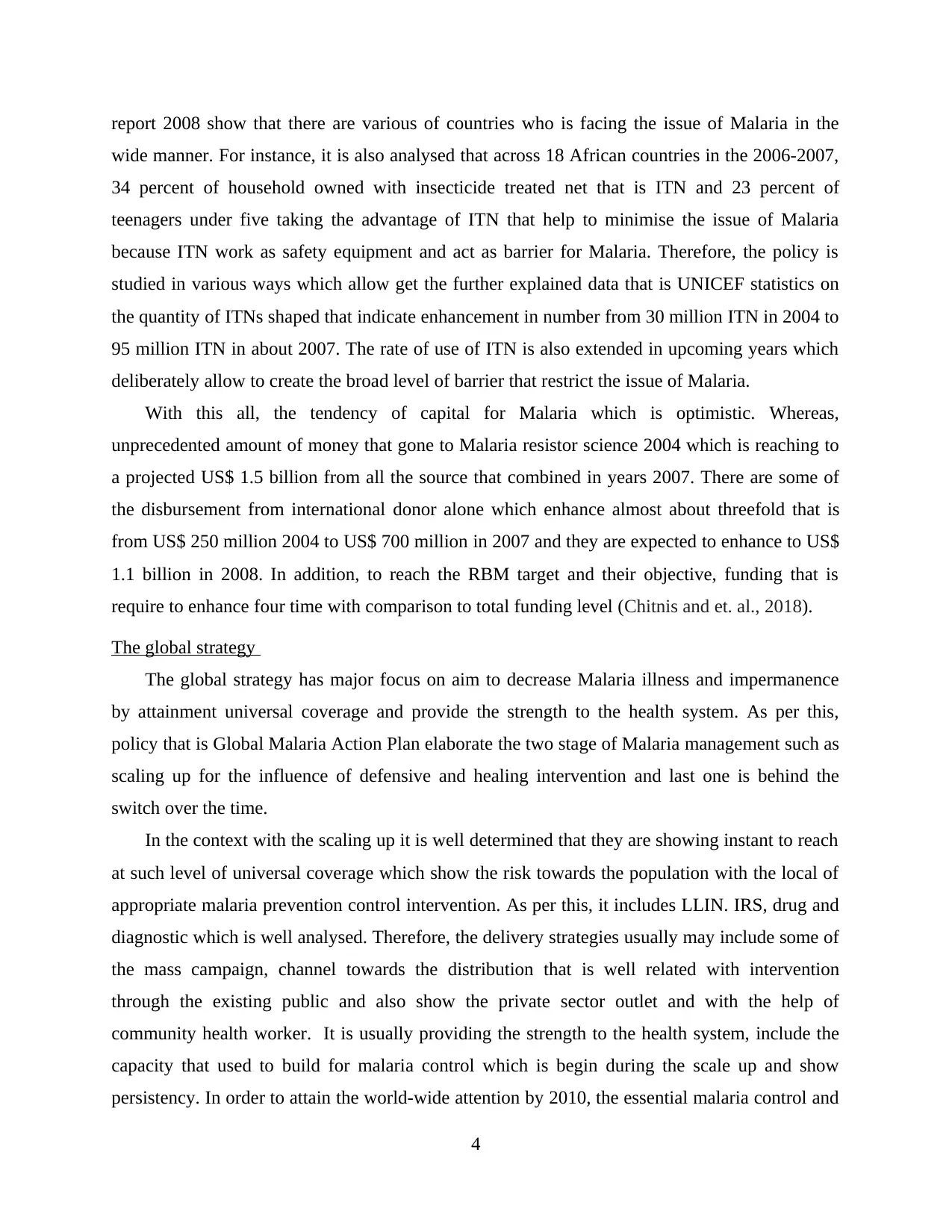
report 2008 show that there are various of countries who is facing the issue of Malaria in the
wide manner. For instance, it is also analysed that across 18 African countries in the 2006-2007,
34 percent of household owned with insecticide treated net that is ITN and 23 percent of
teenagers under five taking the advantage of ITN that help to minimise the issue of Malaria
because ITN work as safety equipment and act as barrier for Malaria. Therefore, the policy is
studied in various ways which allow get the further explained data that is UNICEF statistics on
the quantity of ITNs shaped that indicate enhancement in number from 30 million ITN in 2004 to
95 million ITN in about 2007. The rate of use of ITN is also extended in upcoming years which
deliberately allow to create the broad level of barrier that restrict the issue of Malaria.
With this all, the tendency of capital for Malaria which is optimistic. Whereas,
unprecedented amount of money that gone to Malaria resistor science 2004 which is reaching to
a projected US$ 1.5 billion from all the source that combined in years 2007. There are some of
the disbursement from international donor alone which enhance almost about threefold that is
from US$ 250 million 2004 to US$ 700 million in 2007 and they are expected to enhance to US$
1.1 billion in 2008. In addition, to reach the RBM target and their objective, funding that is
require to enhance four time with comparison to total funding level (Chitnis and et. al., 2018).
The global strategy
The global strategy has major focus on aim to decrease Malaria illness and impermanence
by attainment universal coverage and provide the strength to the health system. As per this,
policy that is Global Malaria Action Plan elaborate the two stage of Malaria management such as
scaling up for the influence of defensive and healing intervention and last one is behind the
switch over the time.
In the context with the scaling up it is well determined that they are showing instant to reach
at such level of universal coverage which show the risk towards the population with the local of
appropriate malaria prevention control intervention. As per this, it includes LLIN. IRS, drug and
diagnostic which is well analysed. Therefore, the delivery strategies usually may include some of
the mass campaign, channel towards the distribution that is well related with intervention
through the existing public and also show the private sector outlet and with the help of
community health worker. It is usually providing the strength to the health system, include the
capacity that used to build for malaria control which is begin during the scale up and show
persistency. In order to attain the world-wide attention by 2010, the essential malaria control and
4
wide manner. For instance, it is also analysed that across 18 African countries in the 2006-2007,
34 percent of household owned with insecticide treated net that is ITN and 23 percent of
teenagers under five taking the advantage of ITN that help to minimise the issue of Malaria
because ITN work as safety equipment and act as barrier for Malaria. Therefore, the policy is
studied in various ways which allow get the further explained data that is UNICEF statistics on
the quantity of ITNs shaped that indicate enhancement in number from 30 million ITN in 2004 to
95 million ITN in about 2007. The rate of use of ITN is also extended in upcoming years which
deliberately allow to create the broad level of barrier that restrict the issue of Malaria.
With this all, the tendency of capital for Malaria which is optimistic. Whereas,
unprecedented amount of money that gone to Malaria resistor science 2004 which is reaching to
a projected US$ 1.5 billion from all the source that combined in years 2007. There are some of
the disbursement from international donor alone which enhance almost about threefold that is
from US$ 250 million 2004 to US$ 700 million in 2007 and they are expected to enhance to US$
1.1 billion in 2008. In addition, to reach the RBM target and their objective, funding that is
require to enhance four time with comparison to total funding level (Chitnis and et. al., 2018).
The global strategy
The global strategy has major focus on aim to decrease Malaria illness and impermanence
by attainment universal coverage and provide the strength to the health system. As per this,
policy that is Global Malaria Action Plan elaborate the two stage of Malaria management such as
scaling up for the influence of defensive and healing intervention and last one is behind the
switch over the time.
In the context with the scaling up it is well determined that they are showing instant to reach
at such level of universal coverage which show the risk towards the population with the local of
appropriate malaria prevention control intervention. As per this, it includes LLIN. IRS, drug and
diagnostic which is well analysed. Therefore, the delivery strategies usually may include some of
the mass campaign, channel towards the distribution that is well related with intervention
through the existing public and also show the private sector outlet and with the help of
community health worker. It is usually providing the strength to the health system, include the
capacity that used to build for malaria control which is begin during the scale up and show
persistency. In order to attain the world-wide attention by 2010, the essential malaria control and
4
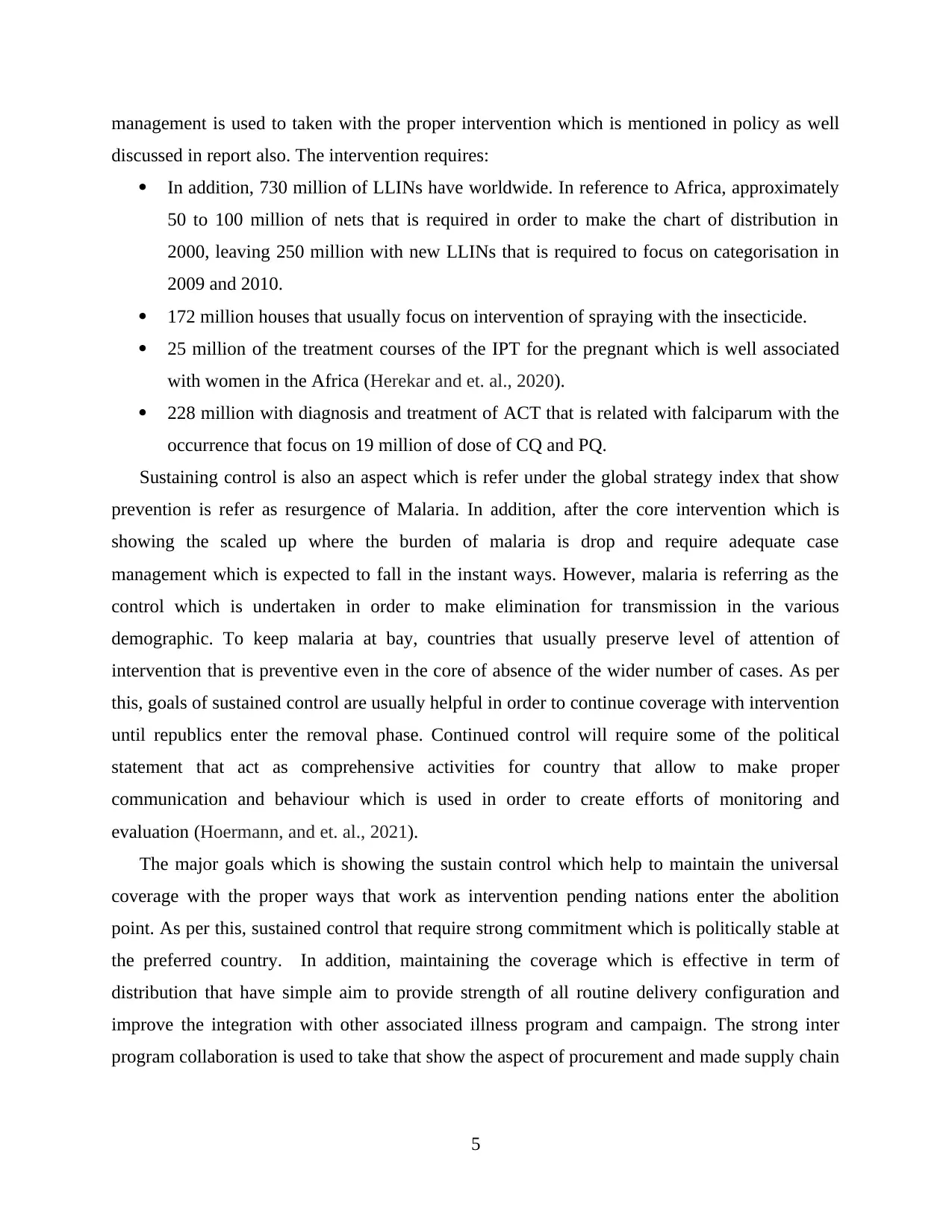
management is used to taken with the proper intervention which is mentioned in policy as well
discussed in report also. The intervention requires:
In addition, 730 million of LLINs have worldwide. In reference to Africa, approximately
50 to 100 million of nets that is required in order to make the chart of distribution in
2000, leaving 250 million with new LLINs that is required to focus on categorisation in
2009 and 2010.
172 million houses that usually focus on intervention of spraying with the insecticide.
25 million of the treatment courses of the IPT for the pregnant which is well associated
with women in the Africa (Herekar and et. al., 2020).
228 million with diagnosis and treatment of ACT that is related with falciparum with the
occurrence that focus on 19 million of dose of CQ and PQ.
Sustaining control is also an aspect which is refer under the global strategy index that show
prevention is refer as resurgence of Malaria. In addition, after the core intervention which is
showing the scaled up where the burden of malaria is drop and require adequate case
management which is expected to fall in the instant ways. However, malaria is referring as the
control which is undertaken in order to make elimination for transmission in the various
demographic. To keep malaria at bay, countries that usually preserve level of attention of
intervention that is preventive even in the core of absence of the wider number of cases. As per
this, goals of sustained control are usually helpful in order to continue coverage with intervention
until republics enter the removal phase. Continued control will require some of the political
statement that act as comprehensive activities for country that allow to make proper
communication and behaviour which is used in order to create efforts of monitoring and
evaluation (Hoermann, and et. al., 2021).
The major goals which is showing the sustain control which help to maintain the universal
coverage with the proper ways that work as intervention pending nations enter the abolition
point. As per this, sustained control that require strong commitment which is politically stable at
the preferred country. In addition, maintaining the coverage which is effective in term of
distribution that have simple aim to provide strength of all routine delivery configuration and
improve the integration with other associated illness program and campaign. The strong inter
program collaboration is used to take that show the aspect of procurement and made supply chain
5
discussed in report also. The intervention requires:
In addition, 730 million of LLINs have worldwide. In reference to Africa, approximately
50 to 100 million of nets that is required in order to make the chart of distribution in
2000, leaving 250 million with new LLINs that is required to focus on categorisation in
2009 and 2010.
172 million houses that usually focus on intervention of spraying with the insecticide.
25 million of the treatment courses of the IPT for the pregnant which is well associated
with women in the Africa (Herekar and et. al., 2020).
228 million with diagnosis and treatment of ACT that is related with falciparum with the
occurrence that focus on 19 million of dose of CQ and PQ.
Sustaining control is also an aspect which is refer under the global strategy index that show
prevention is refer as resurgence of Malaria. In addition, after the core intervention which is
showing the scaled up where the burden of malaria is drop and require adequate case
management which is expected to fall in the instant ways. However, malaria is referring as the
control which is undertaken in order to make elimination for transmission in the various
demographic. To keep malaria at bay, countries that usually preserve level of attention of
intervention that is preventive even in the core of absence of the wider number of cases. As per
this, goals of sustained control are usually helpful in order to continue coverage with intervention
until republics enter the removal phase. Continued control will require some of the political
statement that act as comprehensive activities for country that allow to make proper
communication and behaviour which is used in order to create efforts of monitoring and
evaluation (Hoermann, and et. al., 2021).
The major goals which is showing the sustain control which help to maintain the universal
coverage with the proper ways that work as intervention pending nations enter the abolition
point. As per this, sustained control that require strong commitment which is politically stable at
the preferred country. In addition, maintaining the coverage which is effective in term of
distribution that have simple aim to provide strength of all routine delivery configuration and
improve the integration with other associated illness program and campaign. The strong inter
program collaboration is used to take that show the aspect of procurement and made supply chain
5
Paraphrase This Document
Need a fresh take? Get an instant paraphrase of this document with our AI Paraphraser
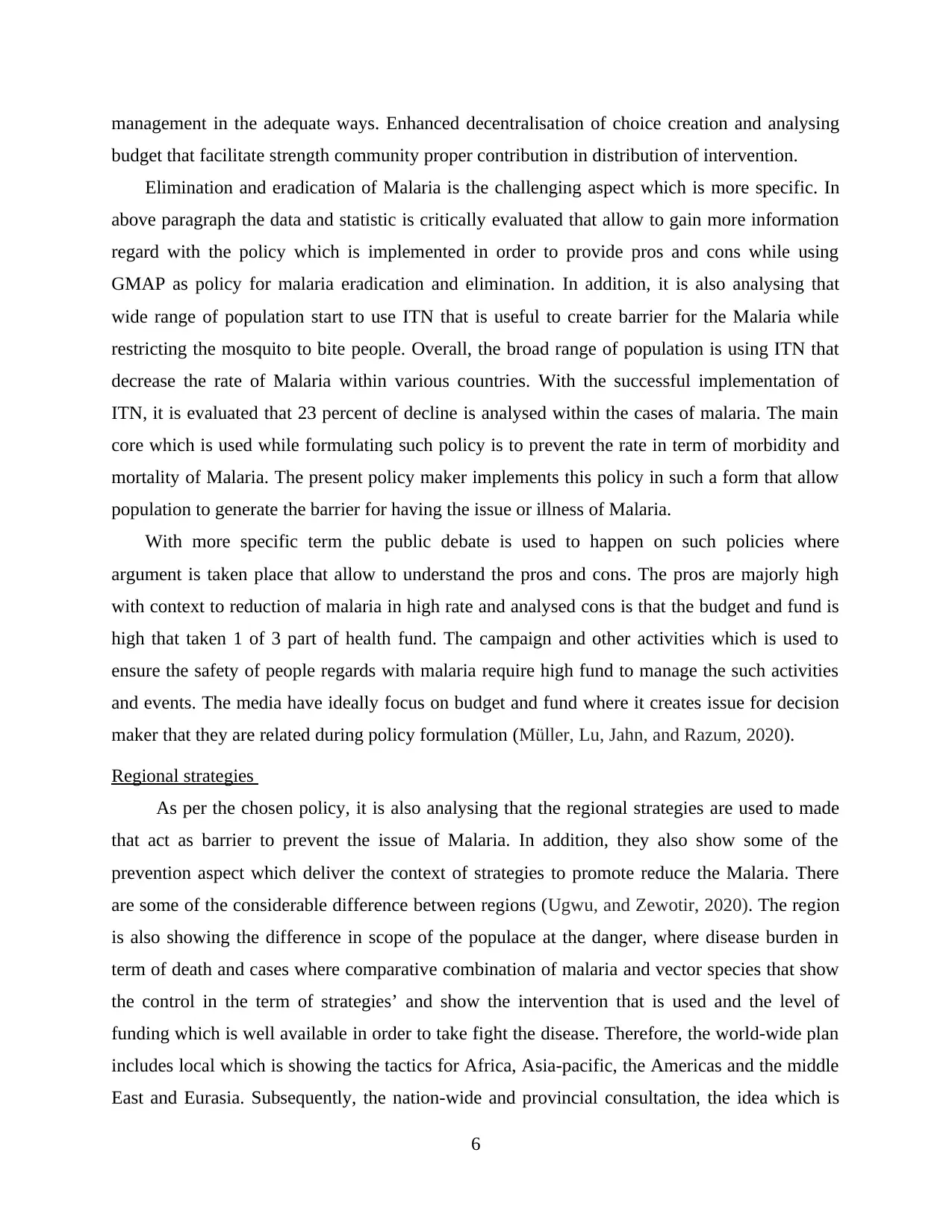
management in the adequate ways. Enhanced decentralisation of choice creation and analysing
budget that facilitate strength community proper contribution in distribution of intervention.
Elimination and eradication of Malaria is the challenging aspect which is more specific. In
above paragraph the data and statistic is critically evaluated that allow to gain more information
regard with the policy which is implemented in order to provide pros and cons while using
GMAP as policy for malaria eradication and elimination. In addition, it is also analysing that
wide range of population start to use ITN that is useful to create barrier for the Malaria while
restricting the mosquito to bite people. Overall, the broad range of population is using ITN that
decrease the rate of Malaria within various countries. With the successful implementation of
ITN, it is evaluated that 23 percent of decline is analysed within the cases of malaria. The main
core which is used while formulating such policy is to prevent the rate in term of morbidity and
mortality of Malaria. The present policy maker implements this policy in such a form that allow
population to generate the barrier for having the issue or illness of Malaria.
With more specific term the public debate is used to happen on such policies where
argument is taken place that allow to understand the pros and cons. The pros are majorly high
with context to reduction of malaria in high rate and analysed cons is that the budget and fund is
high that taken 1 of 3 part of health fund. The campaign and other activities which is used to
ensure the safety of people regards with malaria require high fund to manage the such activities
and events. The media have ideally focus on budget and fund where it creates issue for decision
maker that they are related during policy formulation (Müller, Lu, Jahn, and Razum, 2020).
Regional strategies
As per the chosen policy, it is also analysing that the regional strategies are used to made
that act as barrier to prevent the issue of Malaria. In addition, they also show some of the
prevention aspect which deliver the context of strategies to promote reduce the Malaria. There
are some of the considerable difference between regions (Ugwu, and Zewotir, 2020). The region
is also showing the difference in scope of the populace at the danger, where disease burden in
term of death and cases where comparative combination of malaria and vector species that show
the control in the term of strategies’ and show the intervention that is used and the level of
funding which is well available in order to take fight the disease. Therefore, the world-wide plan
includes local which is showing the tactics for Africa, Asia-pacific, the Americas and the middle
East and Eurasia. Subsequently, the nation-wide and provincial consultation, the idea which is
6
budget that facilitate strength community proper contribution in distribution of intervention.
Elimination and eradication of Malaria is the challenging aspect which is more specific. In
above paragraph the data and statistic is critically evaluated that allow to gain more information
regard with the policy which is implemented in order to provide pros and cons while using
GMAP as policy for malaria eradication and elimination. In addition, it is also analysing that
wide range of population start to use ITN that is useful to create barrier for the Malaria while
restricting the mosquito to bite people. Overall, the broad range of population is using ITN that
decrease the rate of Malaria within various countries. With the successful implementation of
ITN, it is evaluated that 23 percent of decline is analysed within the cases of malaria. The main
core which is used while formulating such policy is to prevent the rate in term of morbidity and
mortality of Malaria. The present policy maker implements this policy in such a form that allow
population to generate the barrier for having the issue or illness of Malaria.
With more specific term the public debate is used to happen on such policies where
argument is taken place that allow to understand the pros and cons. The pros are majorly high
with context to reduction of malaria in high rate and analysed cons is that the budget and fund is
high that taken 1 of 3 part of health fund. The campaign and other activities which is used to
ensure the safety of people regards with malaria require high fund to manage the such activities
and events. The media have ideally focus on budget and fund where it creates issue for decision
maker that they are related during policy formulation (Müller, Lu, Jahn, and Razum, 2020).
Regional strategies
As per the chosen policy, it is also analysing that the regional strategies are used to made
that act as barrier to prevent the issue of Malaria. In addition, they also show some of the
prevention aspect which deliver the context of strategies to promote reduce the Malaria. There
are some of the considerable difference between regions (Ugwu, and Zewotir, 2020). The region
is also showing the difference in scope of the populace at the danger, where disease burden in
term of death and cases where comparative combination of malaria and vector species that show
the control in the term of strategies’ and show the intervention that is used and the level of
funding which is well available in order to take fight the disease. Therefore, the world-wide plan
includes local which is showing the tactics for Africa, Asia-pacific, the Americas and the middle
East and Eurasia. Subsequently, the nation-wide and provincial consultation, the idea which is
6
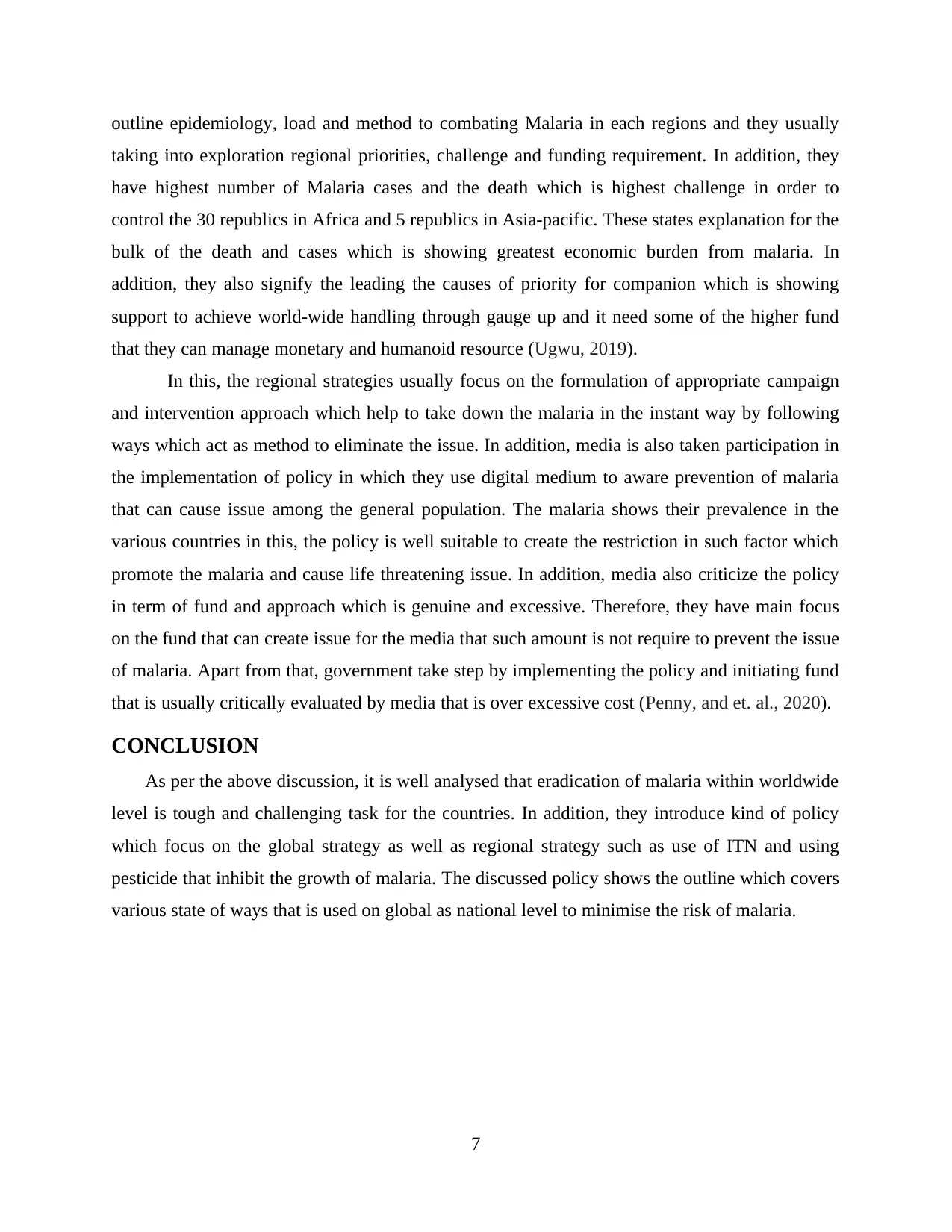
outline epidemiology, load and method to combating Malaria in each regions and they usually
taking into exploration regional priorities, challenge and funding requirement. In addition, they
have highest number of Malaria cases and the death which is highest challenge in order to
control the 30 republics in Africa and 5 republics in Asia-pacific. These states explanation for the
bulk of the death and cases which is showing greatest economic burden from malaria. In
addition, they also signify the leading the causes of priority for companion which is showing
support to achieve world-wide handling through gauge up and it need some of the higher fund
that they can manage monetary and humanoid resource (Ugwu, 2019).
In this, the regional strategies usually focus on the formulation of appropriate campaign
and intervention approach which help to take down the malaria in the instant way by following
ways which act as method to eliminate the issue. In addition, media is also taken participation in
the implementation of policy in which they use digital medium to aware prevention of malaria
that can cause issue among the general population. The malaria shows their prevalence in the
various countries in this, the policy is well suitable to create the restriction in such factor which
promote the malaria and cause life threatening issue. In addition, media also criticize the policy
in term of fund and approach which is genuine and excessive. Therefore, they have main focus
on the fund that can create issue for the media that such amount is not require to prevent the issue
of malaria. Apart from that, government take step by implementing the policy and initiating fund
that is usually critically evaluated by media that is over excessive cost (Penny, and et. al., 2020).
CONCLUSION
As per the above discussion, it is well analysed that eradication of malaria within worldwide
level is tough and challenging task for the countries. In addition, they introduce kind of policy
which focus on the global strategy as well as regional strategy such as use of ITN and using
pesticide that inhibit the growth of malaria. The discussed policy shows the outline which covers
various state of ways that is used on global as national level to minimise the risk of malaria.
7
taking into exploration regional priorities, challenge and funding requirement. In addition, they
have highest number of Malaria cases and the death which is highest challenge in order to
control the 30 republics in Africa and 5 republics in Asia-pacific. These states explanation for the
bulk of the death and cases which is showing greatest economic burden from malaria. In
addition, they also signify the leading the causes of priority for companion which is showing
support to achieve world-wide handling through gauge up and it need some of the higher fund
that they can manage monetary and humanoid resource (Ugwu, 2019).
In this, the regional strategies usually focus on the formulation of appropriate campaign
and intervention approach which help to take down the malaria in the instant way by following
ways which act as method to eliminate the issue. In addition, media is also taken participation in
the implementation of policy in which they use digital medium to aware prevention of malaria
that can cause issue among the general population. The malaria shows their prevalence in the
various countries in this, the policy is well suitable to create the restriction in such factor which
promote the malaria and cause life threatening issue. In addition, media also criticize the policy
in term of fund and approach which is genuine and excessive. Therefore, they have main focus
on the fund that can create issue for the media that such amount is not require to prevent the issue
of malaria. Apart from that, government take step by implementing the policy and initiating fund
that is usually critically evaluated by media that is over excessive cost (Penny, and et. al., 2020).
CONCLUSION
As per the above discussion, it is well analysed that eradication of malaria within worldwide
level is tough and challenging task for the countries. In addition, they introduce kind of policy
which focus on the global strategy as well as regional strategy such as use of ITN and using
pesticide that inhibit the growth of malaria. The discussed policy shows the outline which covers
various state of ways that is used on global as national level to minimise the risk of malaria.
7
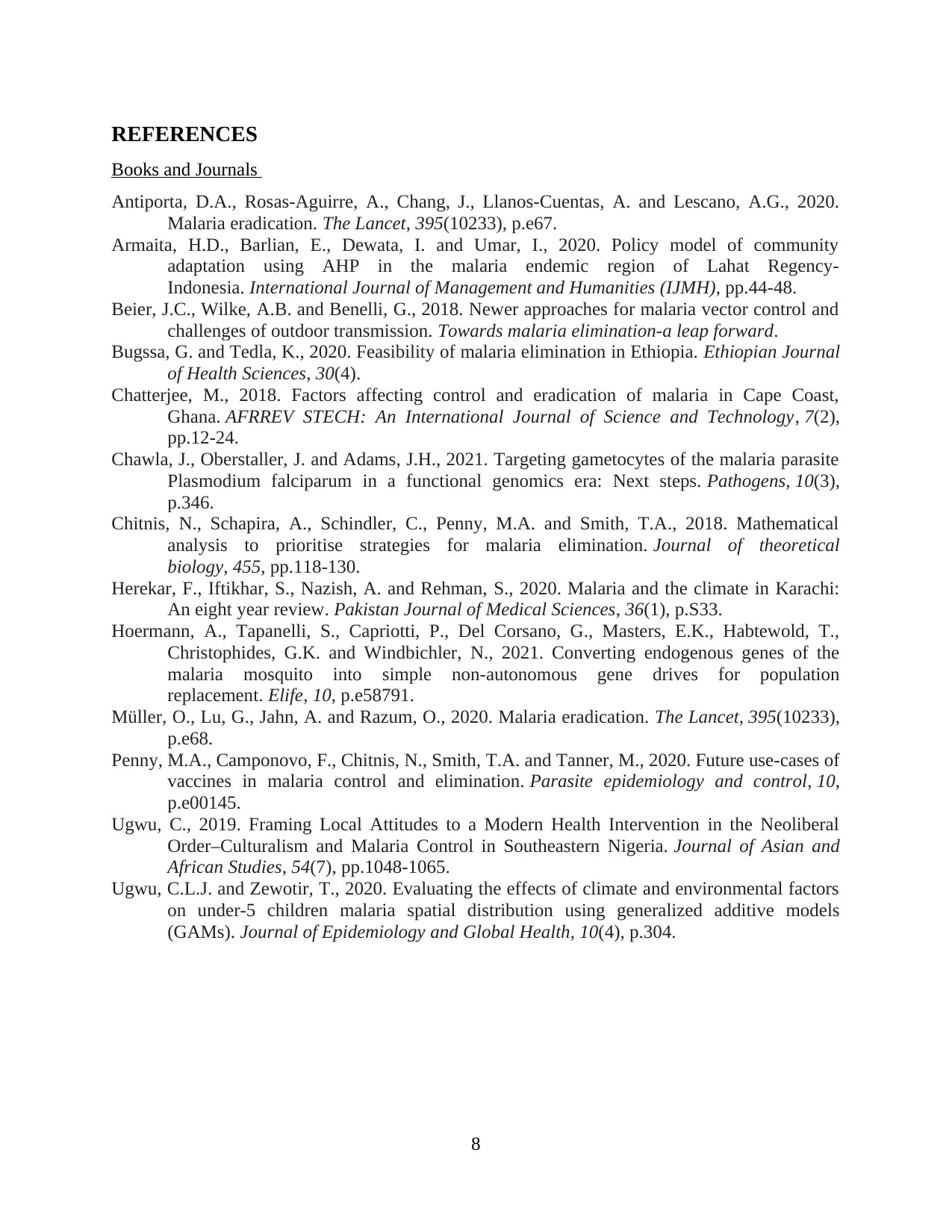
REFERENCES
Books and Journals
Antiporta, D.A., Rosas-Aguirre, A., Chang, J., Llanos-Cuentas, A. and Lescano, A.G., 2020.
Malaria eradication. The Lancet, 395(10233), p.e67.
Armaita, H.D., Barlian, E., Dewata, I. and Umar, I., 2020. Policy model of community
adaptation using AHP in the malaria endemic region of Lahat Regency-
Indonesia. International Journal of Management and Humanities (IJMH), pp.44-48.
Beier, J.C., Wilke, A.B. and Benelli, G., 2018. Newer approaches for malaria vector control and
challenges of outdoor transmission. Towards malaria elimination-a leap forward.
Bugssa, G. and Tedla, K., 2020. Feasibility of malaria elimination in Ethiopia. Ethiopian Journal
of Health Sciences, 30(4).
Chatterjee, M., 2018. Factors affecting control and eradication of malaria in Cape Coast,
Ghana. AFRREV STECH: An International Journal of Science and Technology, 7(2),
pp.12-24.
Chawla, J., Oberstaller, J. and Adams, J.H., 2021. Targeting gametocytes of the malaria parasite
Plasmodium falciparum in a functional genomics era: Next steps. Pathogens, 10(3),
p.346.
Chitnis, N., Schapira, A., Schindler, C., Penny, M.A. and Smith, T.A., 2018. Mathematical
analysis to prioritise strategies for malaria elimination. Journal of theoretical
biology, 455, pp.118-130.
Herekar, F., Iftikhar, S., Nazish, A. and Rehman, S., 2020. Malaria and the climate in Karachi:
An eight year review. Pakistan Journal of Medical Sciences, 36(1), p.S33.
Hoermann, A., Tapanelli, S., Capriotti, P., Del Corsano, G., Masters, E.K., Habtewold, T.,
Christophides, G.K. and Windbichler, N., 2021. Converting endogenous genes of the
malaria mosquito into simple non-autonomous gene drives for population
replacement. Elife, 10, p.e58791.
Müller, O., Lu, G., Jahn, A. and Razum, O., 2020. Malaria eradication. The Lancet, 395(10233),
p.e68.
Penny, M.A., Camponovo, F., Chitnis, N., Smith, T.A. and Tanner, M., 2020. Future use-cases of
vaccines in malaria control and elimination. Parasite epidemiology and control, 10,
p.e00145.
Ugwu, C., 2019. Framing Local Attitudes to a Modern Health Intervention in the Neoliberal
Order–Culturalism and Malaria Control in Southeastern Nigeria. Journal of Asian and
African Studies, 54(7), pp.1048-1065.
Ugwu, C.L.J. and Zewotir, T., 2020. Evaluating the effects of climate and environmental factors
on under-5 children malaria spatial distribution using generalized additive models
(GAMs). Journal of Epidemiology and Global Health, 10(4), p.304.
8
Books and Journals
Antiporta, D.A., Rosas-Aguirre, A., Chang, J., Llanos-Cuentas, A. and Lescano, A.G., 2020.
Malaria eradication. The Lancet, 395(10233), p.e67.
Armaita, H.D., Barlian, E., Dewata, I. and Umar, I., 2020. Policy model of community
adaptation using AHP in the malaria endemic region of Lahat Regency-
Indonesia. International Journal of Management and Humanities (IJMH), pp.44-48.
Beier, J.C., Wilke, A.B. and Benelli, G., 2018. Newer approaches for malaria vector control and
challenges of outdoor transmission. Towards malaria elimination-a leap forward.
Bugssa, G. and Tedla, K., 2020. Feasibility of malaria elimination in Ethiopia. Ethiopian Journal
of Health Sciences, 30(4).
Chatterjee, M., 2018. Factors affecting control and eradication of malaria in Cape Coast,
Ghana. AFRREV STECH: An International Journal of Science and Technology, 7(2),
pp.12-24.
Chawla, J., Oberstaller, J. and Adams, J.H., 2021. Targeting gametocytes of the malaria parasite
Plasmodium falciparum in a functional genomics era: Next steps. Pathogens, 10(3),
p.346.
Chitnis, N., Schapira, A., Schindler, C., Penny, M.A. and Smith, T.A., 2018. Mathematical
analysis to prioritise strategies for malaria elimination. Journal of theoretical
biology, 455, pp.118-130.
Herekar, F., Iftikhar, S., Nazish, A. and Rehman, S., 2020. Malaria and the climate in Karachi:
An eight year review. Pakistan Journal of Medical Sciences, 36(1), p.S33.
Hoermann, A., Tapanelli, S., Capriotti, P., Del Corsano, G., Masters, E.K., Habtewold, T.,
Christophides, G.K. and Windbichler, N., 2021. Converting endogenous genes of the
malaria mosquito into simple non-autonomous gene drives for population
replacement. Elife, 10, p.e58791.
Müller, O., Lu, G., Jahn, A. and Razum, O., 2020. Malaria eradication. The Lancet, 395(10233),
p.e68.
Penny, M.A., Camponovo, F., Chitnis, N., Smith, T.A. and Tanner, M., 2020. Future use-cases of
vaccines in malaria control and elimination. Parasite epidemiology and control, 10,
p.e00145.
Ugwu, C., 2019. Framing Local Attitudes to a Modern Health Intervention in the Neoliberal
Order–Culturalism and Malaria Control in Southeastern Nigeria. Journal of Asian and
African Studies, 54(7), pp.1048-1065.
Ugwu, C.L.J. and Zewotir, T., 2020. Evaluating the effects of climate and environmental factors
on under-5 children malaria spatial distribution using generalized additive models
(GAMs). Journal of Epidemiology and Global Health, 10(4), p.304.
8
Secure Best Marks with AI Grader
Need help grading? Try our AI Grader for instant feedback on your assignments.

9

10
1 out of 12
Related Documents
Your All-in-One AI-Powered Toolkit for Academic Success.
+13062052269
info@desklib.com
Available 24*7 on WhatsApp / Email
![[object Object]](/_next/static/media/star-bottom.7253800d.svg)
Unlock your academic potential
© 2024 | Zucol Services PVT LTD | All rights reserved.





